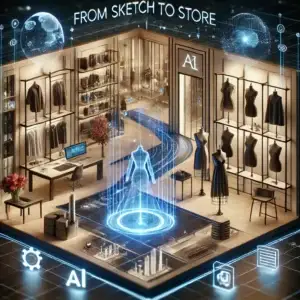Introduction
The world of fashion is undergoing a seismic shift, with technology rapidly transforming the way fashion is designed, produced, and consumed. Yet, the question arises—are fashion schools adequately preparing students for this digital evolution? When fashion design software, virtual try-ons, and 3D pattern design are the norm, it’s important to examine whether fashion degrees are truly keeping up with the needs of the modern industry. Let’s explore the alignment, or lack thereof, between traditional fashion education and the digital age.
Good Fashion Colleges: Preparing for the Future or Stuck in the Past?
Many fashion colleges continue to offer apparel design courses rooted in traditional techniques. While foundational skills are essential, the lack of focus on digital tools leaves students unprepared for modern fashion jobs. Schools that fail to integrate technologies like fashion design software and virtual try-on tools into their curriculum risk producing graduates who are behind the curve. Fashion is no longer just about sketching by hand or sewing patterns; it’s about leveraging technology to enhance creativity and efficiency.
Top Fashion Schools Falling Behind
Some of the top fashion degrees are still lacking in digital education. Famous institutions such as Central Saint Martins and Parsons School of Design excel in creativity but lag behind in adopting technological tools. But forward-thinking schools like the Fashion Institute of Technology (FIT) and Polimoda are integrating courses on 3D modeling, digital pattern design, and apparel design programs that teach the next generation of fashion innovators.
The Rise of Fashion Design Software in Education
Fashion design software has revolutionized the way designers work. Software like CLO 3D, Browzwear, and TUKACAD lets designers create intricate 3D designs without needing to produce physical samples. This saves time and reduces waste—a major concern in today’s sustainability-focused world. Yet, many fashion colleges have been slow to adopt these tools as part of their cloth design courses.
Fashion schools should prioritize integrating fashion design software into apparel design courses. Mastery of these tools is not optional—it’s essential for anyone entering the modern fashion workforce. Virtual try-on technology, for example, lets designers test how a garment looks and moves without needing to produce it first, opening new doors for creativity and precision.
Key Features of Fashion Design Software in Education
- 3D Pattern Design: Instead of relying on traditional patterns, students can design intricate 3D garments, tweaking every aspect to ensure a perfect fit.
- Fabric Simulation: Software now allows the simulation of different fabrics, giving designers the ability to experiment with textures and colors in a digital space.
- Digital Sewing: Virtual sewing techniques reduce the need for physical prototypes, saving time and resources in the design process.
Virtual Try-On: The Future of Fashion Design
The demand for virtual try-on technology is growing, as brands like Zara and Gucci embrace augmented reality to enhance the customer experience. In fashion schools, virtual try-ons should be part of the curriculum in fashion degrees, letting students see how their designs fit and move on a digital model. Virtual try-ons go beyond just aesthetics—they also help solve issues related to size and fit, which can make or break a designer’s reputation in the fast-paced fashion world.
Patterns Design: From Physical to Digital
Another critical area where fashion schools must evolve is in patterns design. While traditional methods of hand-drawing patterns still have value, today’s designers need to know how to create digital patterns using the latest technology. Digital pattern design is faster, more efficient, and far less wasteful than older methods. Plus, it’s far easier to tweak and share digital patterns globally, allowing for real-time collaboration on collections across borders.
Schools Leading the Way in Digital Fashion Education
Not all fashion schools are behind the curve. Institutions like the London College of Fashion and Savannah College of Art and Design (SCAD) are already leading the way by offering apparel design programs that focus heavily on digital tools. These schools teach students how to use fashion design software and other modern technologies to their advantage, preparing them for a world where virtual try-ons and digital pattern design are becoming the standard.
Examples of Forward-Thinking Schools (Non-exhaustive list)
- Fashion Institute of Technology (FIT): Offers courses on 3D pattern design, CLO 3D, and virtual sampling, ensuring students are prepared for the digital future.
- Polimoda: Provides specialized programs focusing on the integration of fashion design software, making graduates tech-savvy and industry-ready.
- London College of Fashion: One of the pioneers in offering digital fashion courses, from 3D modeling to augmented reality for fashion.
The Future of Fashion Education: Adapting to the Digital Age
The future of fashion education is digital. Schools that fail to integrate the latest technology will inevitably produce graduates who are ill-equipped for the challenges of the modern fashion industry. Fashion degrees must evolve to include the traditional elements of fashion design and cutting-edge tools like fashion design software, virtual try-on technology, and digital pattern design.
Students today need a hybrid education that combines creativity with technology. Apparel design programs that fail to incorporate these digital elements risk becoming obsolete, much like the outdated techniques they continue to teach.
Conclusion
The fashion world is changing, and so must the institutions that teach it. While some schools are leading the charge by integrating digital tools into their cloth design courses, others are lagging behind, leaving their students at a disadvantage. As technology continues to reshape the fashion landscape, good fashion schools will be those that embrace the future, equipping students with the tools they need to succeed in an increasingly digital world.
FAQs:
1. Why is technology important in modern fashion education?
Technology is revolutionizing the fashion industry by introducing tools like 3D modeling, digital pattern design, and virtual try-ons. These innovations enhance creativity, improve efficiency, and align with sustainability goals. Incorporating these tools into fashion education ensures students are industry-ready.
2. What is the main criticism of traditional fashion schools?
Many traditional fashion schools focus heavily on foundational skills like hand-sketching and physical sewing, which, while important, often exclude training on modern tools like fashion design software. This leaves graduates underprepared for contemporary fashion roles that demand technological expertise.
3. Which software tools are transforming fashion design education?
Some of the leading tools include:
- CLO 3D and Browzwear for 3D garment modeling.
- TUKACAD for digital pattern-making.
- Fabric simulation and virtual sewing technologies that streamline the design process.
4. What are the benefits of learning digital pattern design?
Digital pattern design allows for faster creation, easier adjustments, and real-time collaboration. It minimizes waste compared to traditional methods and enables seamless sharing of patterns globally, fostering efficiency and sustainability.
5. How are virtual try-ons impacting the fashion industry?
Virtual try-ons allow designers to visualize how garments fit and move on digital models, eliminating the need for physical samples. This innovation is increasingly used by brands and schools, offering a more interactive and precise design process.
6. Which fashion schools are leading in digital fashion education?
Notable institutions integrating technology into their curricula include:
- Fashion Institute of Technology (FIT): Offers courses in CLO 3D and virtual sampling.
- Polimoda: Focuses on software-driven fashion design.
- London College of Fashion: Pioneers in teaching 3D modeling and augmented reality.
- Savannah College of Art and Design (SCAD): Known for digital-forward apparel programs.
7. What challenges do students face when schools lag behind in technology adoption?
Students risk entering the workforce without critical skills in digital tools, putting them at a disadvantage in a competitive, tech-driven industry. They may also miss opportunities to innovate sustainably and collaborate globally.





